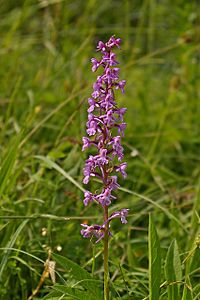Ridley Bottom, Tidenham facts for kids
Ridley Bottom is a special nature reserve in Gloucestershire, England. It covers about 1.1 hectares, which is like 2.7 acres. This beautiful area is protected because it's a "Key Wildlife Site." The Gloucestershire Wildlife Trust takes care of Ridley Bottom. It became one of their first nature reserves in 1985. It was given to them to remember Mr. K. Ridley, who loved nature and supported the Trust.
Contents
Discovering Ridley Bottom's Location and Habitats
Ridley Bottom is a quiet and small nature reserve. You can find it near Tidenham, between Parson's Allotment and Turnips Grove. The reserve has three small fields and some coppiced woodland. It sits on a gentle slope that faces north. The ground here is made of Carboniferous limestone and Red Sandstone.
The fields at Ridley Bottom have not been changed by farming. This means they are very natural. To keep them healthy, the fields are cut for hay in summer. Then, sheep graze there from August until the end of the year. This helps the plants grow well.
Amazing Meadow Flowers and Plants
The meadows at Ridley Bottom are surrounded by old lime hedgerows. These hedges are like natural fences. Many beautiful meadow plants grow here. You can spot cowslip, lady's bedstraw, and common milkwort. Other flowers include salad burnet, field scabious, yellow-wort, and the lovely fragrant orchid.
Some plants that usually grow in woodlands are also found here. These include wood anemone and primrose. This tells us that these fields might have been a forest a long, long time ago.
More special plants have been seen at Ridley Bottom. These include heath spotted-orchid and lesser butterfly-orchid. You might also find adder's-tongue, which is a type of fern. Other interesting plants are common cow-wheat, lousewort, bitter-vetch, and tormentil.
Exploring the Woodland Trees and Plants
The wooded part of Ridley Bottom is a piece of very old forest. It has small-leaved lime trees, ash trees, oaks, and birch trees. These are some of the oldest trees in the area.
Below the taller trees, you'll find a layer of shrubs. This layer includes hazel, holly, yew, dogwood, field maple, and whitebeam. In spring, the woodland floor comes alive with flowers. Look for bluebells, early purple orchids, wood anemones, and herb paris. You can also see primroses, snowdrops, woodruff, and yellow archangel.
Birds and Butterflies of Ridley Bottom
Ridley Bottom is a great home for many animals. Both the woodlands and grasslands support different species. Many birds live here, like the blackcap and linnet. You might also hear the tree pipit or see a coal tit. Other birds include the goldcrest, European turtle dove, pied wagtail, and jackdaw. The great spotted woodpecker can also be found tapping on trees.
The reserve is also a good place for butterflies. Some of the butterflies recorded here are the holly blue and speckled wood. You might also spot the colorful peacock butterfly or the beautiful pearl-bordered fritillary.
Protecting Ridley Bottom's Nature
Keeping Ridley Bottom healthy needs careful work. Besides the sheep grazing and hay cutting, the woodland needs thinning. This means removing some trees to help others grow better. The hedges also need to be trimmed and layered. This helps them stay strong and provides good homes for wildlife.
Walks and Nearby Nature Spots
There is a special guide that describes walks in the Wye Valley. These walks are great for enjoying nature and seeing amazing views. The guide includes information about the famous Offa's Dyke Path and the Gloucestershire Way.
You can also learn about other interesting places nearby. These include Devil's Pulpit (Tintern), Lippets Grove, and Passage Grove. The guide also covers Caswell Woods SSSI, Oakhill Wood, East Wood, Tidenham nature reserve, and Poor's Allotment SSSI. Ridley Bottom is one of the many wonderful nature spots you can explore in this area.


